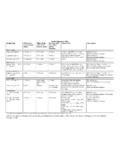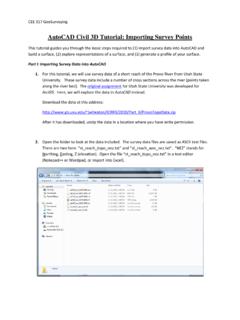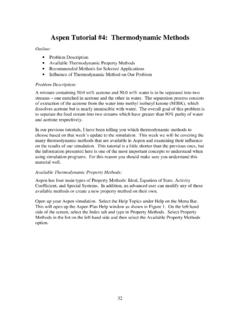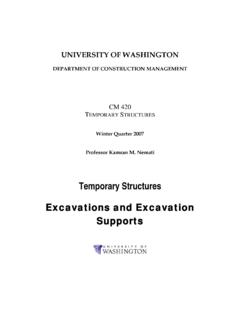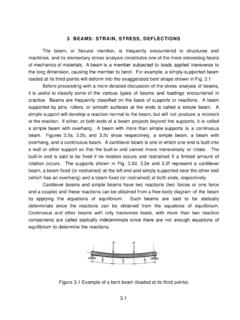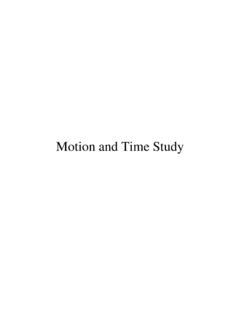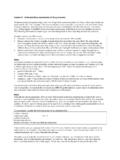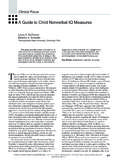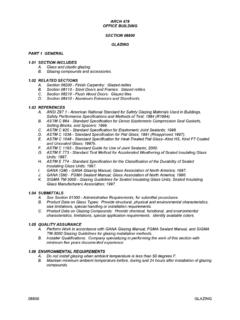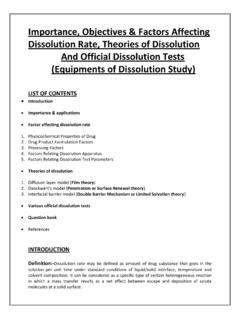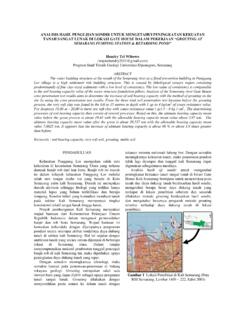Transcription of The Hall Effect - University of Washington
1 The hall Effect1 BackgroundIn this experiment, the hall Effect will be used to study some ofthe physics of charge transport inmetal and semiconductor 1879 E. H. hall observed that when an electrical current passes through a sample placed in amagnetic field, a potential proportional to the current and tothe magnetic field is developed acrossthe material in a direction perpendicular to both the current and to the magnetic field [1]. Thiseffect is known as the hall effect, and is the basis of many practical applications and devices suchas magnetic field measurements, and position and motion the measurements he made, hall was able to determine forthe first time the sign of chargecarriers in a conductor.
2 Even today, hall effect measurementscontinue to be a useful techniquefor characterizing the electrical transport properties ofmetals and semiconductors. Indeed, thefailure of the simple model of metallic conductivity, whichwe discuss below, to account for manyexperimental measurements of the hall effect has been one of the principal motivators leading to abetter understanding of electronic properties of materials [5, pp. 58 62]. The simple theory of the hall effectConsider a conducting slab as shown in Fig. 1 with lengthLin thexdirection, widthwin theydirection and thicknesstin 1: Geometry of fields and sample in hall effect the conductor to have charge carrier of chargeq(can be either positive or negative or both,but we take it to be of just one sign here), charge carrier number densityn( , number of carriersper unit volume), and charge carrier drift velocityvxwhen a currentIxflows in the positivexdirection.
3 The drift velocity is an average velocity of the charge carriers over the volume of theconductor; each charge carrier may move in a seemingly random way within the conductor, butunder the influence of applied fields there will be a net transport of carriers along the length of theconductor. The currentIxis the current densityJxtimes the cross-sectional area of the conductor1wt. The current densityJxis the charge densitynqtimes the drift velocityvx. In other wordsIx=Jxwt=nqvxwt .(1)The currentIxis caused by the application of an electric field along the length of the conductorEx. In the case where the current is directly proportional to the field, we say that the materialobeys Ohm s law, which may be writtenJx= Ex,(2)where is the conductivity of the material in the assume that the conductor is placed in a magnetic field perpendicular to the plane of the charge carriers will experience a Lorentz forceq~v ~Bthat will deflect them toward one sideof the slab.
4 The result of this deflection is to cause an accumulation of charges along one side ofthe slab which creates a transverse electric fieldEythat counteracts the force of the magnetic field.(Recall that the force of an electric field on a chargeqisq~E.)When steady state is reached, there will be no net flow of chargein theydirection, since theelectrical and magnetic forces on the charge carriers in that direction must be balanced. Assumingthese conditions, it is easy to show thatEy=vxBz,(3)whereEyis the electric field, called the hall field, in theydirection andBzthe magnetic field an experiment, we measure the potential difference across the sample the hall voltageVH which is related to the hall field byVH= w0 Eydy= Eyw.
5 (4)Thus, from equations (1), (3) and (4) we obtainVH= (1nq)IxBzt.(5)The term in parenthesis is known as the hall coefficient:RH=1nq.(6)It is positive if the charge carriers are positive, and negative if the charge carriers are negative. Inpractice, the polarity ofVHdetermines the sign of the charge carriers. Note that the SI units ofthe hall coefficient are [m3/C] or more commonly stated [m3/A-s].Exercise 1 Work through the math to derive Eq. (5). Now consider that an electric current in thepositivexdirection can be created by positive charges moving positive along thexaxis or negativecharges moving negative along thexaxis.
6 Draw diagrams showing the electric and magnetic forceson the charges to convince yourself that, in spite of this fact, positive charge carriers will producea positive hall coefficient and negative charge carriers will produce a negative hall The hall effect in metals and semiconductorsIn order to understand some of the ideas involved in theory ofthe hall effect in real materials, itis instructive to construct a more careful model for electric currents under electric and magneticfields from a classical point of view. We imagine that the charge carriers move in a medium thatoffers some resistance. The resistance is due to scattering between the carriers and impurities inthe material and between the carriers and vibrations of the material s atoms.
7 Each charge carrieris accelerated by the applied fields but every so often it scatters and loses energy. If we assumethat the average time between scattering events is , then we have, on average, a retarding forceacting on the carriers of~Fretard= m~v ,(7)wheremis the mass of the carrier. So under the influence of applied electric and magnetic fields,Newton s second law readsmd~vdt=q(~E+~v ~B) m~v ,(8)where the velocity~vis taken to be an average over all of the steady state, the time derivative of~vwill vanish. Under the usual convention that~Bpointsalong thezaxis, we obtain the component equations for~vby setting the left hand side of Eq.
8 (8)to zero and rearranging:vx=q mEx+q mBzvy,vy=q mEy q mBzvx,(9)vz=q Eq. (1) we have thatJx=nqvx(and correspondingly foryandzcomponents). By solvingthe above equations forvx,vyandvzin terms of the components of~EandBzwe getJx= 1 + ( c )2(Ex+ c Ey),Jy= 1 + ( c )2(Ey c Ex),(10)Jz= Ez,where nq2 m,(11)and c qBzm.(12)In the expression for the conductivity it may seem that all we have done is to replace oneunknown quantity~vwith another unknown quantity . But the parameter , called therelaxationtime, is widely used in discussions of electronic transport in materials, and can be justified in aquantum-mechanical context via the Boltzmann transport equation [8, Ch.]
9 7]3 The angular frequency cis known as as the cyclotron frequency . It is the frequencyof rota-tion of a charge in a magnetic field, and can be taken as a measureof the strength of the combination c is used to characterize an experimental situation: if the magnetic field isweak and/or the relaxation time short, c 1 and our experiment is in the weak-field limit ;alternately if c 1 the experiment is in the strong-field limit . A number of materials showstrikingly different behavior between the weak- and strong-field limits; aluminum is our classical model of the hall effect with a single type of charge carrier, however, there is nosuch crossover between the weak and strong field.
10 This can be proved by working out the 2 Show that a classical charged particle of chargeq, massmand speedvwould execute acircular orbit of angular frequency cif it moves under the influence of a magnetic field~B. Assumethat no other forces act on the 3 Solve equations 10 under the conditions thatJy=Jz= 0to show two results:Jx= ExandJx= Ey/( c ). Define the hall coefficient asRH Ey/(BJx)and show thatRH=1/(nq).Note that this model predicts two things: the hall coefficient is independent of the magnetic fieldstrength and that there is no dependence of the sample resistance on the magnetic field either.

